Editor of this issue: Thomas Remeikis
Copyright © 1964 LITUANUS Foundation, Inc.

|
LITUANUS
LITHUANIAN
QUARTERLY JOURNAL OF ARTS AND SCIENCES
Volume 10, No.1 - Spring 1964
Editor of this issue: Thomas Remeikis ISSN 0024-5089
Copyright © 1964 LITUANUS Foundation, Inc. |

|
PAUL RĖKLAITIS
POVILAS RĖKLAITIS, Lithuanian art historian, a frequent contributor to scholarly journals, holds a Ph.D. from the University of Tuebingen (1949). His latest work is: Einfuehrung in die Kunstgeschichtsforschung des Grossfuerstentums Litauen, Marburg-Lahn, Herder Institute, 1962.
ICONOGRAPHY OF THE LITHUANIAN PEASANT IN LITHUANIA MINOR
Introductory Remarks
In examining the available documentary materials on the biography of Kristijonas Donelaitis, we encounter a paradox: there is not a single authentic portrait of the poet, whereas there is quite extensive pictorial documentation of the Lithuanian peasantry in eighteenth-nineteenth century Prussia, whom Donelaitis had so vividly described in his poem. In fact, the iconography of the Lithuanian peasant in Lithuania Minor is much more extensive than that of Lithuania Proper.
This situation is not difficult to explain. As early as the eighteenth century, German etnographers had turned their attention to Lithuanian peasants living in the Prussian state, because the Lithuanians, having maintained their ancient language and customs, constituted an exotic element among the inhabitants of Prussia. In Lithuania itself, on the other hand, interest in etnography arose somewhat later — only in the nineteenth century — and was not systematic. Furthermore, Prussia had more experienced painters and engravers capable of .creating high-quality illustrations of etnographic wonders of their land. In general, it can be maintained that even though the peasant of Lithuania Minor in the eighteenth and nineteenth centuries was socially degraded and even exploited, nevertheless, the society of the age of reformation, enlightenment, and romantism treated him humanely and with respect. Theologians counselled and taught them, scientists described them and began research into their language and poetry, philosophers like Immanuel Kant appreciated their moral character, and poets like Donelaitis composed songs about them; meanwhile, artists depicted them on canvas and provided us with documents of their appearance and dress.
The artists were Germans; therefore, iconography of the Lithuanian created by them should properly be called "German iconography of the Lithuanian peasant." This is important to note, because in viewing their illustrations we must not forget their relative value. Illustrations of Lithuanians drawn from a German point of view imply certain deviations, not so much in the area of material culture as in the psychological representation of the people. The pictures were not drawn as dolls demonstrating national costumes; their authors also sought to express the anthropological and psychological character of an ethnic group, even though in special costume and ethnographic works the anthropological aspect was not essential.
The pictorial illustrations of Lithuanian peasants in Lithuania Minor presented in this article are quite rare; they are found only in older literature and archives. No attempt is made to describe the costumes, their origin and forms; this is a legitimate task of the ethnographer. Only where illustrative bias or errors are present, they are pointed out and corrected. The iconography here presented is at best partial; there can be little doubt that in. the extensive ethnographic literature of Prussia and in the remaining archival materials which survived destruction of war in Germany and Lithuania itself, there are still many more pictorial documents on the peasants of Lithuania Minor of. the Donelaitian epoch.
All the illustrations, except those of the painter Gisevius, are reproductions from originals. The libraries of the following institutions in Marburg-Lahn were used in collecting these illustrations: (1) J. G. Herder-Institut, (2) Stiftung Preussischer Kulturbesitz-Staatsbibliothek, (3) Universitaetsbibliothek, (4) Kunsthistorisches Seminar der Universitaet. In addition, one photograph was obtained from the Germanisches-Nationalmuseum in Nuernberg and one from Sweden.
Eighteenth-Nineteenth Centuries: Hartknoch and Lepner
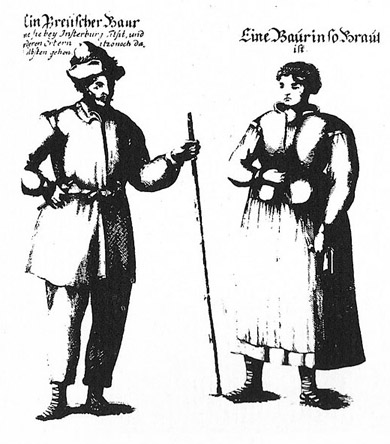 |
Plate 1. Lithuanian Peasant and Lithuanian Bride. Copperplate-engraving, 200 x 180 mm. Reproduced from the original in J. G. Herder Institut in Marburg. From Christophorum Hąrtknoch's Alt-und Neues Preussen oder Preussiscke Historien zwey Theile, Frankfurt und Leipzig, 1684, between pp. 600 and 601. Inscription on the engraving above the man: "Ein Preuscher Baur, wie sie bey Insterburg, Tilsit und anderen Oerten itzo noch da selbsten gehen"; inscription above the bride: "Ein Bauerin, so Braut ist". In the seventeenth century around Insterburg and Tilsit the Prussians were already nonexistent and all peasants in these localities before the great plague epidemic (1709-1711) were Lithuanians. Thus the pictured peasant types must be Lithuanians. The man has an ax under his belt, while the bride wears a wreath of rues on her head. |
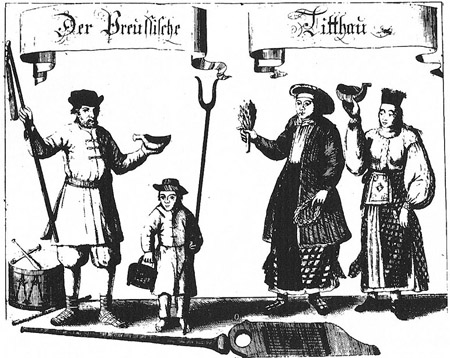 |
Plate 2 Family of a Lithuanian Peasant. Copperplate engraving. Reproduced from Der Preusche Littauer oder Vorstellung der Nahmens-Herleitung, Kinds-Tauffen, Hochzeit, Nahrung und Ackerbau, Speise und Trauck, Sprache, Gottes-Dienst, Begraebnisse und andere dargleichen Sachen der Littauer in Preussen kuerzlich zusammen getragen von Theo-doro Lepner, Ersten Pfarrer der Deutschen und Littauischen Gemeinde Gottes in Budwethen. In Jahr nach werthen Heylander Geburt 1690 Danzig, bey Joh. Heinrich Ruedigern 1744. Reproduced here from the original. Inscription on the engraving: "Der Preussische Litthau". As a frontpiece engraving it vividly symbolizes the contents described in the title page: Lithuanian peasants — father, child, mother, and daughter-bride with the traditional rue wreath on her hat, all with typical attire, household and work implements. Below, musical instruments: drum, flute, trumpet, the Lithuanian zither (kanklės). (Lepner has a special chapter on Lithuanian musical instruments in ťhe above:cited work: "X. Der Littauer Music und derselben Instrumenten."). it is not known whether the engraving was based on some drawing or painting, which could have been attached to the 1690 manuscript of Rev. Lepner, or whether it was prepared later, before printing. Therefore it can be dated between 1690 and 1744, but not in 1690. This engraving is often reproduced (not from the original) unclearly and partially, without the inscription at the top. |
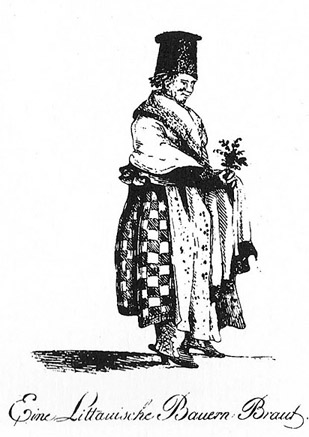 |
Plate 3. Lithuanian Bride. A colored lithograph, made with pen. Reproduced from the original in the Germanisches Nationalmuseum in Nuerenberg. Size: 215 x 159 mm. Inscription: "Eine Littauische Bauern Braut." Bride's cap similar to that of the bride in Lepner's work (see Plate 2), though overly 'heightened; on top of the hat the traditional rue wreath. Presentation is highly caricaturized. According to Luitpold Dusler, Die Incunabeln der deutschen Lithographie (1796-1821), Heidelberg, 1955, p. 221, this lithograph was prepared by August Riedel ca. 1812. This is a doubtful contention, for the Bavarian artist August Riedel (1799-1881) was only ten years old in 1812. Apparently the drawing for this lithograph was made ca. 1800. |
Nineteenth Century: Eduard Gisevius
The artist Eduard Gisevius (1798-1880) provided a larger number of illustrations of Lithuanian peasants from Lithuania Minor as they appeared in the middle of the nineteenth century. Gisevius studied law and philosophy in the University of Kornigslierg; in 1825 he was appointed to a teaching position in Tilsit and dedicated his life to ethnographic documentation of the Lithuanian nation. Quietly working as a researcher, Gisevius collected not only folklore, folksongs, and legends, but also, being an amateur artist, he depicted Lithuanian dress, customs, and environment in many of his paintings. The ethnographic paintings of Gisevius were not intellectual; he painted his subjects quite naively, though sincerely and with impressively simple means (cf. Nikola Michailow, "Zur Begriffsbestimmung der Laienmalerei" Zeitschrijt fuer Kunstgeschichte, Leipzig, 1935, p. 288).
After Gisevius' death, his artistic heritage was kept at the Prussia Museum in Koenigsberg. His paintings were not investigated or appraised; we do not know what his technique was or what were the essential characteristics of his colors. The paintings of Gisevius, together with the Prussia Museum, were destroyed during the war — a great loss of materials for Lithuanian ethnography and for the history of art. All that remains of Gisevius' work are several imperfect reproductions in varipus publications. [About the fate of the Prussia Museum, See J. Puzinas, "Prussia muziejus", Lietuvių Enciklopedija (Lithuanian Encyclopedia), Boston, 1961, vol. XXIV, p. 162].
Some indication of the scope of Gisevius' art may be gained from the still available catalogues of his exhibits. The 1900 Prussia Museum catalog mentions 8 exhibited paintings of Gisevius, depicting Lithuanian costumes (Cf. Katalog de s Prussia-Museums in Nordfluegel des Koeniglichen Schlosses zu Koenigsberg i. Pr., 1900, pp. 67-68, nos. 314-321). There must have been many more of his paintings in existence at that time. Some claim as many as 150 (cf. V. Biržiška in Lietuvių Enciklopedija, vol. VII, p. 287).
In 1929, 126 paintings of Gisevius were exhibited in Koenigsberg, 120 (nos. 1-120) of which were from the Prussia Museum collection and 6 (nos. 121-126) from the Tilsit Museum. See the exhibit catalog, Eduard Gisevius (Tilsit, Preussisch-Litauische Landschaften und Trachten vor 1850, Sommer-Ausstellung 7, Juli bis 15, September 1929, Im Kroenungssaal des Schlosses Koenigsberg, p. 12) Of the 126 exhibited paintings, 49 were dated between 1829 and 1878. Some of the paintings still had original explanations, locality, and authentic names, provided by Gisevius himself. There were 31 paintings depicting typical Lithuanian costumes, in which one or more groups of women were so arranged as to show their dress from all sides. Somewhat less known were his portraits of Lithuanian peasant women, evidently ten of which were exhibited in 1929. In the portraits we see a special attention to the head-garb. Some of the portraits have authentic names: "Busze Sargunikke aus Mazurmaten Kirchspiel Wilkischken- 1841"; "Urte Paskarbaitiene, geborene Pakullyte aus Erimaiten bei Tilsit 1845", "Auguze Szlypatene, geborene Tenikaitikke 1885", "Dastile Sturnkatene, geborene Auskalaitikke mit Kykas", "Lyne Pawandena-tikke in Vorder-und Seitenansicht", "Maedchen aus Ragnit: Ille Szo-rikke", "Anorte Betikke aus Bittenen." Two paintings each are devoted to illustrate Lithuanian wedding customs, labor and game scenes, interior of the house, individual homestead buildings, and total village panorama. Among the unusual paintings is "King of Prussia Friedrich Wilhelm IV, accompanied by Lithuanian girls riding on stallions." The remaining paintings exhibited in 1929 were landscapes from various localities on both sides of the river Nemunas (Nemen). Gisevius was also interested in Lithuania Proper, as evidenced by his landscapes from Samogitia, and four views of the City of Kaunas,
Following are some of the remaining reproductions of Gisevius' art.
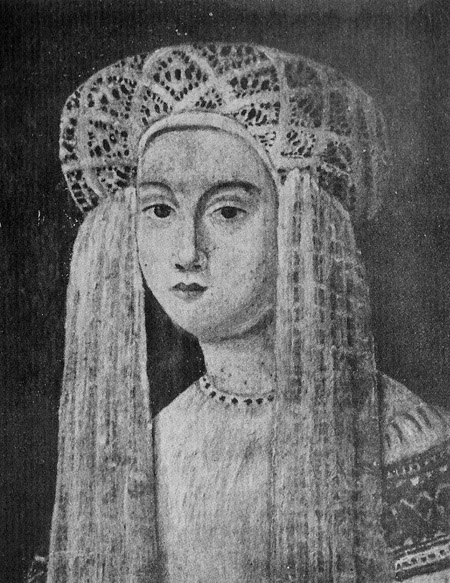 |
Plate 4. Tuze Ywolaitene, born Petkike. Painting by E. Gisevius. Reproduced here from: E. Gisevius, Tilsit, Sommerausstellung, op. cit. Koenigsberg, 1929, p. 5, no. 91. Catalog description: "Tuze Ywolaitene, geborene Petkikke mit Kykas (Weiberhaube)." Formerly owned by the Prussia Museum. |
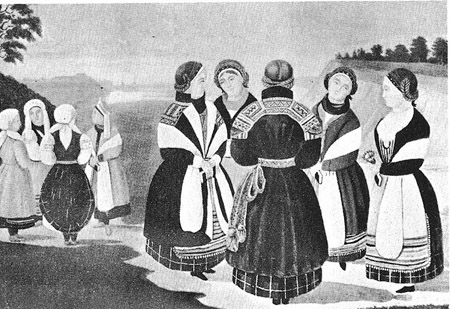 |
Plate 5. Lithuanian Women on the Banks of Nemunas. Painting by E. Gisevius, ca. 1840. Reproduced here from: Zeitechrift fuer Kunstge-schichte, Leipzig, 1935, p. 290. "E. Gisevius. Frauen am Memelufer, um 1840. Prussia-M'useum, Koenigsberg." |
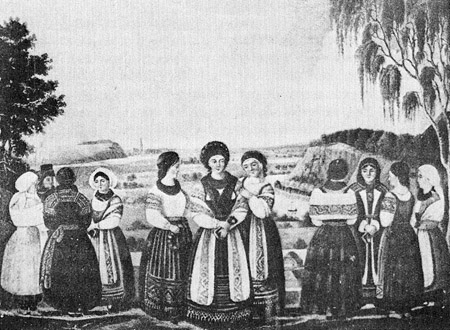 |
Plate 6. In the Valley of Nemunas, with Lithuanian Women in Folk Dress. Painting by E. Gisevius, 1839. Reproduced here from: Eduard Gisevius, Tilsit, Sommerausstellung, op. cit., Koenigsberg, 1929, p. 6, no. 32: "Tal der Memel bei Tilsit mit Volkstrachten in Vordergrund 1839." |
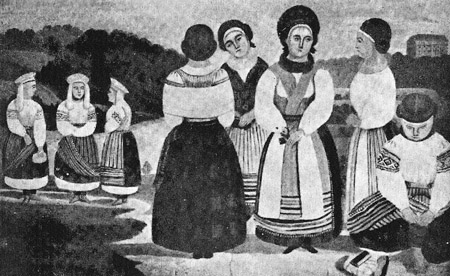 |
Plate 7. Lithuanian Women on the Banks of Nemunas, with the Castle of Ragaine in the Background. Painting by E. Gisevius. Reproduced from: Eduard Gisevius, Tilsit Sommerausstellung, op. cit., Koenigsberg, 1929, p. 7, no. 110. "Litauische Frauen an der Memel mit Schloss Ragnit in Hintergrund." |
Nineteenth-Twentieth Centuries: Kretschmer and Hottenroth
Pictures of Lithuanian costumes are well represented in books of German folk dress. Albert Kretschmer's work Deutsche Volkstrachten, Leipzig, 1887-1890, is one such collection, presenting the folk costumes of the inhabitants of various German provinces within the borders of the Second Reich. In the 1870 edition Kretschmer omitted Prussian Lithuania. The 1890 edition, however, was supplemented with 10 plates on Schleswig-Holstein, Prussian Lithuania, and the reclaimed province of Elzas-Lotharingia (in the Introduction). There are four pages of text devoted to the description of Lithuanian dress. Chrome lithographs "were made from Kretschmer's watercolors.
It is not known what interested Kretschmer in Lithuanian peasant dress. At approximately that time, Minzloff took Lithuanian ethnographic photographs in Tilsit; these photographs are mentioned by Justus Sauerwein-Girenas. Later Sauerwein himself published a booklet in which he also wrote about Lithuanian folk attire (see his Ueber littauisches Volksthum und littauisches Volkstracht. Culturgeschichtliches Gespraech zwischen der Herren Germanus und Lituanus, veranlasst durch die Minzloffschen Littauer-Photographien und zur Erlaeterung derselben von Girėnas. Gedrucht bei Otto v. Mauderode in Tilsit 1894, p. 48).
Kretschmer's work, with its large chrome lithographs, considerably popularized the interest in folk dress, but his 90 plates did not cover materials from all provinces. Thus, a larger work on German costumery was prepared. In 1902 Hottenroth published a three-part work on costumes, with 215 black-white and 144 colored plates. Hottenroth himself did not investigate Lithuanian folk dress, nor did he search for new material. He merely compiled the data from Lepner's work, op. cit. (for the eighteenth-nineteenth centuries) and from Kretschmer's work, op. cit. (for the nineteenth century). In addition, Hottenroth included illustrations of Lithuanian peasants from Cesare Vercellio's work, without considering that Vercellio's illustrations were of Lithuanian boyars from Lithuania Proper. For some reason, however, Hottenroth failed to utilize the rich Gisevius collection.
Hottenroth failed to contribute new materials to the history of costumery; he merely systematized the available materials. His drawings, based on the cited sources, are interesting only in that they interpret Lithuanian anthropological types naturally, but without expressing authenticity or the essence of Lithuanian character.
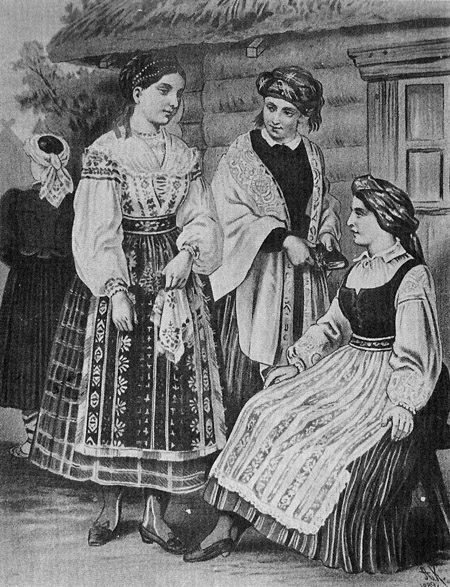 |
Plate 8. Lithuanian Girls in a Holiday Dress. Watercolor by Albert Kretschmer, 1889. Size: 248 x 199 mm. Chrome lithography by Gustav Leutzsch, Gera. The painting is signed "A.K. 1889," Reproduced here from the original in the Library of Marburg University. Albert Kretschmer, Deutsche Volkstrachten, 2 Aufl. Leipzig 1887-1890: Taf. 12 "Litauen." |
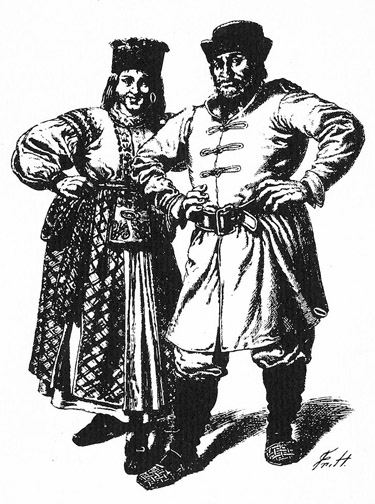 |
Plate 9. Lithuanian Girl from Insterburg and Lithuanian Peasant from Tilsit or Ragnitz. Color autotype; size of the figures 130 x 96 mm. Reproduced here from
Friedrich Hottenroth, Deutsche
Volkstrachten von XVI bis гит XIX
Jahrhundert, Frankfurt a. M., 2 Aufl. 1928, Т. Ill, Taf.
26: "Preussen,
erste Haelfte des 18. Jahrhunderts. Maedchen aus Insterburg. Bauer aus
Tilsit oder Ragnitz" (!). Here Hottenroth follows Lepner (see plates 1
and 2). |